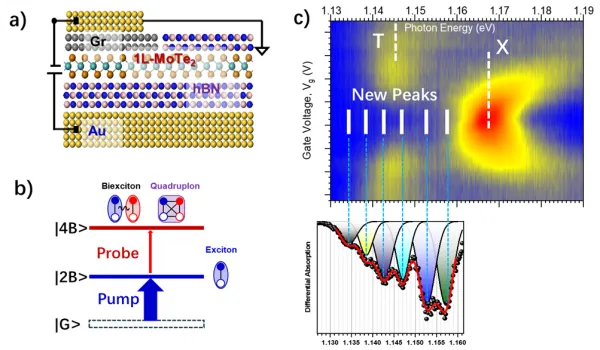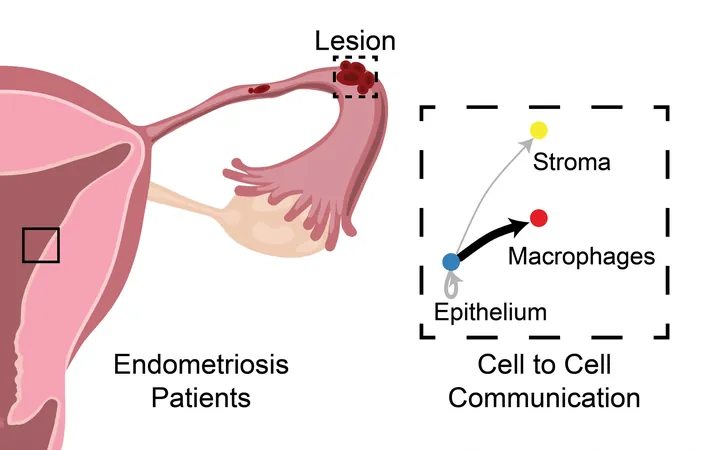
Groundbreaking Discovery: Scientists Unveil New Four-Body Quasi-Particle in 2D Semiconductors!
2025-03-27
Author: Nur
In an exciting development in the field of condensed matter physics, researchers have unveiled evidence supporting the existence of a new quasi-particle known as the quadruplon, which consists of four entangled particles. This groundbreaking discovery, led by Professor Cun-Zheng Ning from Shenzhen Technology University and Tsinghua University in China, offers fresh insights into the intricate behaviors of two-dimensional materials like Molybdenum Ditelluride.
The understanding of material properties—ranging from their electrical and optical capabilities to their thermal and magnetic behaviors—is essential for advancing technological applications. This study explores the realm of quasi-particles, which are collective excitations in a material that govern these properties. Familiar examples include phonons and excitons, where the latter are created by the coupling of electrons and holes in semiconductors.
Unlike bi-excitons, which are arrangements of two excitons that together fit into a two-body category, quadruplons represent a novel four-body interaction that has, until now, remained elusive in experimental setups, especially in semiconductors.
In their recent article published in eLight, the research team detailed how they created a device using a monolayer of Molybdenum Ditelluride housed between thin boron nitride layers to control charge density. By tuning the gate voltage and employing an advanced optical pump-probe technique, they could observe the intricate dynamics and spectral responses of these emerging quasi-particles.
"We were thrilled to discover at least six distinctive spectral peaks beneath the exciton peak in our absorption spectrum—something that has never been documented before," exclaimed Professor Ning. This finding was corroborated after rigorous testing across multiple high-quality samples over a decade of research to ensure that these peaks were intrinsic and not due to defects.
Through systematic temperature and pump power assessments, the researchers were able to confirm the robustness of these new spectral features. Traditional theories surrounding excitons and trions could not account for all the observed phenomena, pushing the team to explore a more comprehensive framework that included complex Coulomb interactions among the four particles.
Utilizing innovative theoretical approaches, including cluster expansions, the team successfully illustrated how these interactions could give rise to the new spectral peaks characteristic of the quadruplon. This approach not only confirmed the relationship between experimental data and theoretical predictions but also clarified the pivotal role of specific particle clusters, particularly the fourth-order cluster that uniquely encapsulates the quadruplon’s composition.
Looking ahead, the implications of this discovery are vast. The team intends to investigate similar phenomena in different materials, exploring the light emission properties of quadruplons that might reveal even more fascinating aspects of quantum physics. The potential applications, from advances in quantum computing to more efficient semiconductor technologies, herald a new era in materials science.
In conclusion, the revelation of the quadruplon provides an essential building block for understanding the complexities of many-body interactions in quantum systems. It sets the stage for future research that promises to deepen our grasp of the quantum world, potentially leading to revolutionary technological advancements. Keep an eye on these developments—they might just change how we interact with the material world!




 Brasil (PT)
Brasil (PT)
 Canada (EN)
Canada (EN)
 Chile (ES)
Chile (ES)
 Česko (CS)
Česko (CS)
 대한민국 (KO)
대한민국 (KO)
 España (ES)
España (ES)
 France (FR)
France (FR)
 Hong Kong (EN)
Hong Kong (EN)
 Italia (IT)
Italia (IT)
 日本 (JA)
日本 (JA)
 Magyarország (HU)
Magyarország (HU)
 Norge (NO)
Norge (NO)
 Polska (PL)
Polska (PL)
 Schweiz (DE)
Schweiz (DE)
 Singapore (EN)
Singapore (EN)
 Sverige (SV)
Sverige (SV)
 Suomi (FI)
Suomi (FI)
 Türkiye (TR)
Türkiye (TR)
 الإمارات العربية المتحدة (AR)
الإمارات العربية المتحدة (AR)